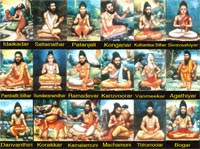Siththars mantrika has its own guiding principles. Siththars have emphasized that these principles should be properly practiced in order to get desired results. In this series, we have seen some information regarding preparation of mantrika in the previous post. On continuation, today we will see information regarding the position of sitting, flowers to be used for pooja and nature of dress to be wore.
One who desired to achieve astha siddhi through mantrika should know about the auspicious variety of wooden plank for sitting and its information is said by Pulipaani Siththar in his songs.
"தானெனபலா பலகை தம்பனந்தானென்ற
thaanenapalaa palakai thambanamthaanenra
தன்மை பெரும் மாம் பலகை மோகனந்தான்
thanmai perum maam palakai moakananthaan
நானென்ற வில்வமது வசியமாகும்
naanenra vilvamathu vasiyamaakum
நல்லபேய்த் தேத்தான் பேதன மதாகும்
nallapaeith thaethaan paethana mathaakum
கானென்ற எட்டி வித்துவேடணந்தான்
kaanenra yeti viththuvaedananthaan
கண்மணியே அத்தியும்மா ரணமதாகும்
kanmaniyae aththiyummaa ranamathaakum
வானென்ற அழைப்பு வெண்நாவலாகும்
vaanenra azhaippu vennaavalaakum
வளமாம் வெப்பாலை யுச்சாடனமாம் பாரே
valamaam veppaalai yuchchadanamaam paarae”
- புலிப்பாணிச் சித்தர் (Pulipaani Sithar)
Jack plank - Thambanam
Mango plank - Mohanam
Bael plank - Vasiyam
Paeithaeththaan plan – Paethanam
Strychnine plank – Viththuvaedanam
Fig plank – Maaranam
Vennaaval (Myrtaceae species) plank – Aakrusanam
Veppaalai (Wrightia tinctoria) plank – Uchaadanam
Pulipaani SIththar have said about the flowers to be used for pooja in order to achieve ashta siddhi through Siththars mantrika.
"பாரப்பா மல்லிகை தான் வசியமாகும்
paarappa mallikai than vasiyamaakum
பகரரிய முல்லை மோகனமு மாகும்
pakarariya mullai mokanamum maakum
ஆரப்பா தும்பையதுச் சாடனந் தான்
aarappa thumpaiathuch saadanan thaan
அப்பனே அரளியா கிருடணந் தான்
appanae araliyaa kirudanan thaan
வாரப்பா காகணத்தி பிரிவுமாகும்
vaarappa kaakanaththi pirivumaakum
வளமான பேதனமூ மத்தம்பூ
valamaana paethanamu maththampoo
நாரப்பா கடலைப்பூமாரணந் தான்
naarappaa kadalaippoomaarananth thaan
நலமான தாமரைதம் பனந் தானாமே
nalamaana thaamaraitham panan thaanaamae”
- புலிப்பாணிச் சித்தர் (Pulipaani Sithar)
Jasmine – Vasiyam
Mullai (Jasminum sambac) – Mohanam
Thumbai (Leucas Aspera) – Uchaadanam
Arali (Oleander)– Aakrusanam
Kaakkanam flower – Vithuvaedanam
Oomatham (Datura species) – Paethanam
Groundnut flower – Maaranam
Lotus – Thambanam
Finally, Pulipaani Siththar gives information about the dress types to wear while practicing mantrika in his following song.
"ஆமப்பா செம்பட்டு வசியமாகும்
aamappa sempattu vasiyamaakum
அப்பனே மஞ்சளது மோகனந்தான்
appanae manjalathu moakananthaan
நாமப்பா பச்சையுந் தம்பனம தாகும்
naamappa pachaiyun thambanam thaakum
நலமான வெள்ளையது பேதனந்தான்
nalamaana vellaiyathu paethananthaan
காமப்பா கழுதை நிறம் வேடணந்தான்
kaamappa kazhuthai niram vaedananthaan
கண்மணியுச் சாட னந்தான் பஞ்சவர்ணம்
kanmaniyuch saada nanthaan panjavarnam
வாமப்பா ஆந்தை வர்ணம் அழைப்பாகும்
vaamappa aanthai varnam azhaipaakum
வளமான கறுப்பு மாரணமாங் கேளே
valamaana karuppu maaranamaang kaelae”
- புலிப்பாணிச் சித்தர் (Pulipaani Sithar)
Red silk - Vasiyam
Yellow silk - Mohanam
Green silk - Thambanam
White silk - Paethanam
Donkey colour silk - Vithuvaedanam
Panjavarna* silk - Uchaadanam
Owl colour silk - Aakrusanam
Black colour silk - Maaranam
With this post preparation for mantrika is over. In upcoming posts, we will see about the each types of mantrika separately.
*Panjavarna – the five colours: white, black, red, yellow and green
Original – www.siththarkal.com
Translated by Lalithambika Rajasekaran

